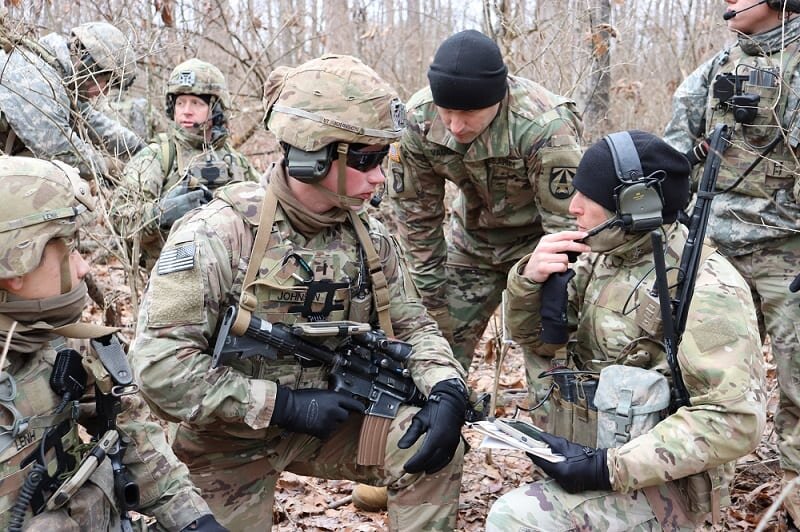By Marty Kauchak
The VR/AR Global Summit in Vancouver is called “one of the year’s most anticipated conferences” by Forbes magazine. Halldale Group Editor Marty Kauchak ventured to the Canadian coastal city to mingle with the international cross-section of thought leaders and developers.
The VR/AR Global Summit offered something for just about every industry: entertainment, sports, healthcare, manufacturing, music, oil and gas, telecommunications, tourism, training of various workforces, even poverty-reduction initiatives. And, of course, the latest hardware and software advancements from tech companies large and small.
The HoloLens2 will be used in the US Army IVAS to help soldiers communicate and coordinate during combat scenarios. Image credit: Microsoft.
There were several defense and aerospace-focused presentations. The most notable a panel on “Immersive Trends in Defense.”There was agreement on the panel that, today, following a four to five-year period of rapid protype development, proofs of concept and testing, a steady rate of initial deliveries and follow on deployments are finally integrating AR/VR into high-risk programs.
Randy Brown, Vice President, Division Manager in the Virtual Heroes Division of Applied Research Associates, noted his company is working on the US Army’s Integrated Visual Augmentation System (IVAS) – the new soldier system to be fielded with an AR capability. The overarching IVAS contract was awarded to Microsoft, with the prototype capabilities enabled by HoloLens2. Brown called attention to the need for the Service to also “integrate many different sensor platforms (night vision goggles, thermal, others) for this to be used as a true visual system.” This effort continues ARA’s decade-long effort with US DoD’s DARPA to build and license a suite of algorithms to support accurate head-tracking and registration, and symbology rendering for dismounted soldiers.
Brown pointed out the challenges to providing immersive technology to the military customer. A short list of impediments includes very restricted networks in terms of low bandwidth and other attributes. Brown also called attention to the military’s focus on SWAP (size, weight and power) when designing VR and AR headsets and related materiel. “For the military to adopt something with a VR or AR capability, it must satisfy the SWAP requirement.” The returns on investment for the customer and supplier is significant when using VR/AR, such as taking hardware into the field to a forward operating base. Indeed, ARA is working on a program to deliver a downrange virtual tactical operation center. “We’ll need enough visual fidelity to have a usable experience there; I think we’ve achieved that,” he concluded.
Applied Research Associates is currently working on the US Army’s Integrated Visual Augmentation System – the new system for soldiers (above) to be fielded with an AR capability. Image Credit: US Army/Kathy Bailey, PEO C3T public affairs.
Jason Radel, Chief Scientist at Dorval, Quebec-based Imagine 4D, indicated one of his team’s most interesting projects is the creation of a “digital twin” of a nuclear facility. Radel explained this effort is leading to the creation of a 3D model to support training and added, “We’re also doing 3D scans to make sure it is photo-realistic.” He emphasized the imperative to deliver a digital twin product – a perfect representative of reality – which will allow the facility’s workers to safely train and work. “Nuclear plants are giant in size, complex and easy to get lost in. You can’t have workers being exposed to radiation while they figure out where they are.”
The company is bringing to bear its Station IX large immersive dome to allow the project team to visualize its data. “Instead of projecting an image on a wall and viewing it directly, we’re actually projecting the image on a screen close to the user and viewing it once it is reflected – there’s a lot of optics in doing this properly. But this gives us real, 3D depth projection.”
Dean Hoover, Systems Engineer at Raytheon, noted one of the biggest challenges to implementing VR/AR in the US military has been culture and an initial hesitancy of some senior leaders who are unfamiliar with the technologies to embrace them. Hoover noted that as senior-level uncertainty and lack of knowledge have been overcome, “the biggest challenge has been keeping up with demand!”
Tyler Gates, Managing Principal at Brightline, noted, “The economy of immersive technology is by and large cheaper, over the long term, [compared to hardware-based systems] because you can create specialized, specific content inside head-on displays, some of which you can buy at a box-store for $200-$900.” He concluded, “When compared to the more expensive cost of comparable hardware, the cost-benefit analysis in favor of AR/VR is further pushing the culture shift away from the legacy product solution. It’s about building software platforms that can scale.”



